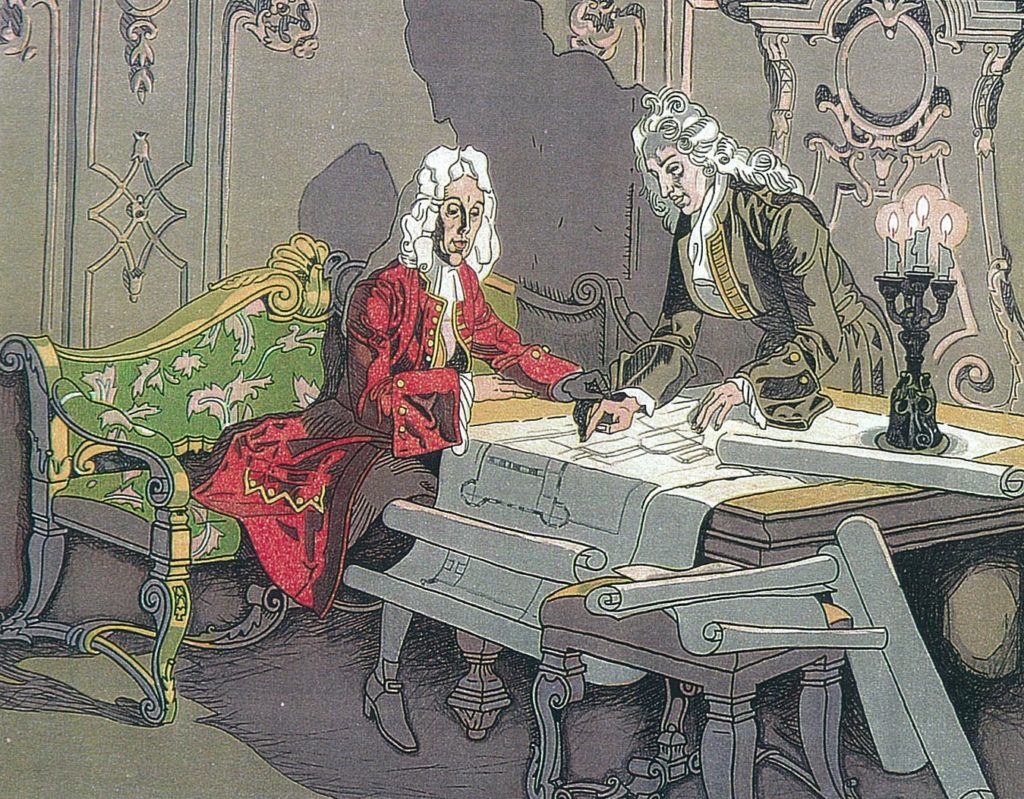(alias Johann Lucas de Hildebrand) is considered one of the most important advocates of European Baroque. He was born in Genoa (Italy), Nov. 14th 1668, the son of Christoph von Hildebrandt, (an Italian and later Austrian army captain of German descend) and Elisabeth de La Tour-Devoir Caetta (a French-Italian countess). Several of his ancestors and relatives have been shaping European culture and history:
Dennies Hildebrand, 445-520, the adviser and weapons master to King Theodoric I “the Great” of Verona (better known as Dietrich von Bern in the Nibelungen Saga). He and his son Hadubrand are the heroes of the “Hildebrandslied”;
Hildebrandt Count of Saona, 1021-1085, the later Pope Gregory VII “Saint Gregory”;
Zacharias Hildebrandt, 1688-1757, famous organ builder and close friend of Johann Sebastian Bach.
Most of his lifetime Johann Lukas von Hildebrandt was hiding his noble descent, because he was a major proponent of the new “modern” stile of baroque and therefore wanted to stay away from the “old-fashioned” medieval ideas his family was associated with.
Hildebrandt studied in Rome under O. Ceruti and C. Fontana (architect of St. Peter in Rome), constructed fortresses during the Italian campaigns under Prince Eugène, and became his favorite architect. He came to Vienna in 1696 where in 1700 he was named Imperial Court Engineer. After 1711 he held the position of Director of the Court Planning Office. In spite of this influential position, he only seldom received contracts from courtly circles due to competition from Johann Bernhard, the father of Joseph Emmanuel Fischer von Erlach. Hildebrandt’s main responsibility was in the area of mundane and sacred constructions dedicated to high-ranking spiritual and worldly dignitaries. His very close friendship with Count Friedrich Carl of Schoenborn and his acquaintance Prince Eugene of Savoy came to have special meaning.

Unlike the monumental works of Fischer von Erlach, Hildebrandt’s works seem more committed and include more decorative elements. This helped Hildebrandt’s popularity spread right through to the “middle class” of European nobility. He, too, united Italian and French elements and shaped the development of the baroque style in Southern Germany and Austria. He built numerous city palaces in Vienna (e.g. Daun-Kinsky, 1716, Harrach 1712) and his religious buildings are also of great importance.
He achieved a grace of proportion and an elegance of style equaled in central European baroque architecture only by the buildings of the Franconian architect Balthasar Neumann, with whom he collaborated on the Würzburg Residenz (1724-44). Hildebrandt was involved in many great projects which were partly carried out by other architects (Wuerzburg, Goettweig, Pommersfelden, Palais Schwarzenberg, Mirabell Palace, etc.).
The most important, however, are the palaces for Count Schoenborn in Goellersdorf (1717), for the imperial family in Halbthurn (1711), and for Prince Eugène in Schlosshof (1729), and Ráckeve (1701ff). Hildebrandt’s later masterpieces include the Winter Palace for the Turkish Conqueror Prince Eugene as well as the Lower and Upper Belvedere (1713-1723), and the Palace Daun-Kinsky erected for Count Wierich Philip Daun in Vienna’s Freyung. In 1720 he received his Austrian knighthood from the Emperor and Austrian King Karl VI.
The famous architect died in Vienna, Nov. 16, 1745. Hildebrandt’s epitaph can be found at Mariabrunn Church in Vienna. The later Austrian Republic has honored his work with several coins and stamps.

Literature:
Grimschitz, Bruno: “Johann Lucas von Hildebrandts kuenstlerische Entwicklung bis zum Jahre 1725” 93 pp. 1 pl. & 79 ills. H.cloth, spine dam. (Kunstgeschichtliche Einzeldarstellungen – Band I, Wien, 1922)
Grimschitz, Bruno, 1959; W. G. Rizzi: “Johann Lucas von Hildebrandt – Ergaenzende Forschungen zu seinem Werk” doctoral thesis, Vienna 1975; NDB.
Grimschitz, Bruno & Dreger, M.: “Johann Lucas von Hildebrandts Kirchenbauten / Zu den Salzburger Kirchenbauten Fischers von Erlach” Augsburg, n.d. pp.205-332. 92 Ills. Wrapp. (Sonderdruck aus dem Wiener Jahrbuch für Kunstgeschichte).
Wilhelm, Franz: Johann Lukas von Hildebrandt. Seine Persönlichkeit und das Verhältnis zu seinen Bauherren. In: Mitteilungen des Vereins für die Geschichte der Stadt Wien 7 (1928), S. 59 – 73.
Seeger, Ulrike: Marly und Rom in Wien: zur Konzeption des Gartenpalais Schönborn in Wien /. In: Zeitschrift für Kunstgeschichte Bd. 62.1999 (1999), S. 366-393.
Rizzi, Wilhelm Georg: Die Kuppelkirchenbauten Johann Lucas von Hildebrandts In: Wiener Jahrbuch für Kunstgeschichte: 1976, v.29.
Kleiner, Salomon: Das Belvedere in Wien. Herausgegeben und kommentiert von Hans Aurenhammer unter Mitarbeit von Gertrude Aurenhammer. (= Wienerisches Welttheater. Das barocke Wien in Stichen von Salomon Kleiner. Bd. 2) Graz 1969.
Gutkas, Karl (Hrsg.): Prinz Eugen und das barocke Österreich. Salzburg, Wien 1985.
Österreichisches Staatsarchiv: “Johann Lucas von Hildebrand – Adelsakt” (Erhebungsurkunde Kaiser Karl VI 10.03.1720, Empfehlungsschreiben von Reichsviezekanzler Fürstbischof Friedrich C. von Schönborn 01.03.1720, Ansuchen J. L. Hildebrand 01.03.1720)
Triumph der Phantasie. Barocke Modelle von Hildebrandt bis Mollinarolo. Österreichische Galerie Belvedere (Hrsg.). Wien, Köln, Weimar 1998.
Additional information have been found in several public archives.The Hildebrandt family inheritance has contributed private documents and correspondence. This web site reflects the up-to-date data available.
